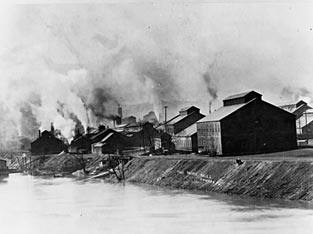Donora, Pennsylvania
Donora, Pennsylvania (40° 10' 33.16"N, 79° 51' 40.55" W), a small industrial town located on the Monongahela River Valley, experienced the worst air pollution disaster in U.S. history in 1948. Pollution from the U.S. Steel Corp.'s Donora Zinc Works smelting operation and other sources containing sulfur, carbon monoxide and heavy metal dusts, was trapped by a weather phenomenon called an inversion, in which a warm air mass traps cold air near the ground. According to the Pennsylvania Bureau of Industrial Hygiene, the pollution came from a combination of the zinc smelting plant, steel mills' open hearth furnaces, a sulphuric acid plant, slag dump, and coal burning steam locomotives and river boats.
The heavy industry of Western Pennsylvania had created pollution problems for nearly a century. By the mid-1900s, other industrial contributors to the pollution that blanketed the air in Donora include the open hearth furnaces of the steel mills, a sulfuric acid plant, slag dumps, coal burning steam locomotives, and river boats. The valley of Donora, surrounded by hills, caused the dense polluted fog to remain close to the ground where people easily inhale the dangerous chemicals.
Between October 26 and 31, 1948, 20 people were asphyxiated and over 7,000 were hospitalized or became ill as the result of severe air pollution. Of the fatalities, two had active pulmonary tuberculosis. The other seventeen were known to have had chronic heart disease or asthma. All were between 52 and 85 years of age. ?As a result of this tragedy in Donora, the U.S. took notice of the industrial pollutants emitted into the air and how they affected human health. Before this smog disaster occurred, the mayor of Pittsburgh anticipated air pollution related health problems. Eventually, the Donora episode helped him to prohibit the use of coal as a residential heating source, replacing it with clean natural gas. By 1952, diesel engines in locomotives and river boats replaced coal power engines. By 1955, almost 97 percent of Pittsburgh’s emissions were reduced and the smog had cleared.
In addition, the Pennsylvania state government established the Division of Air Pollution Control in 1949 to study air quality and its effect on human health. Statewide clean air regulations were enacted in 1966, and in 1970, the Pennsylvania legislature passed an "Environmental Bill of Rights," stating that, among other things, people had a right to clean air.
Further Reading
The Donora Smog Disaster (Pennsylvania State Archives) Andrews, Richard N.L. Managing the Environment, Managing Ourselves: A History of American Environmental Policy. New Haven: Yale University Press, 1999.
